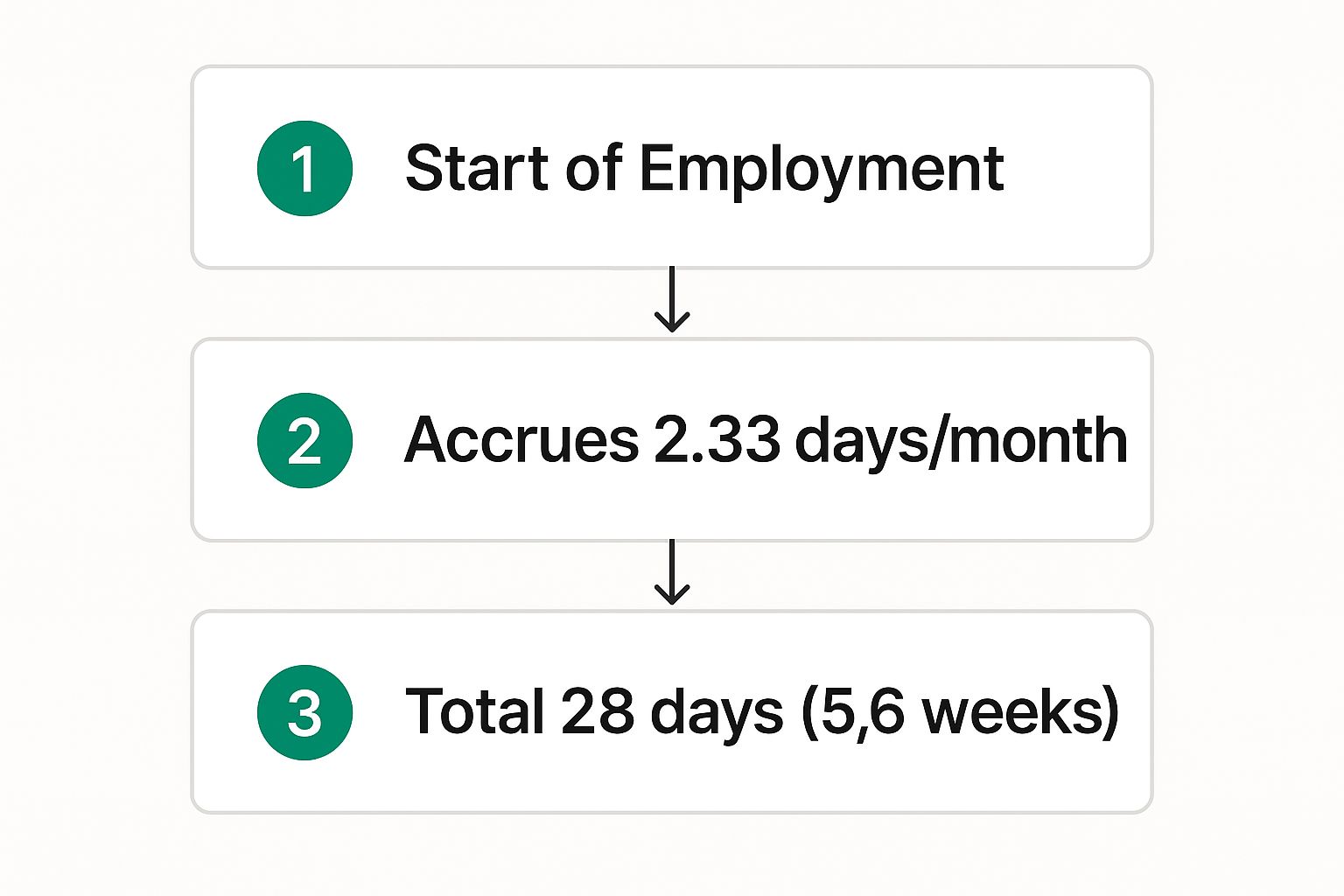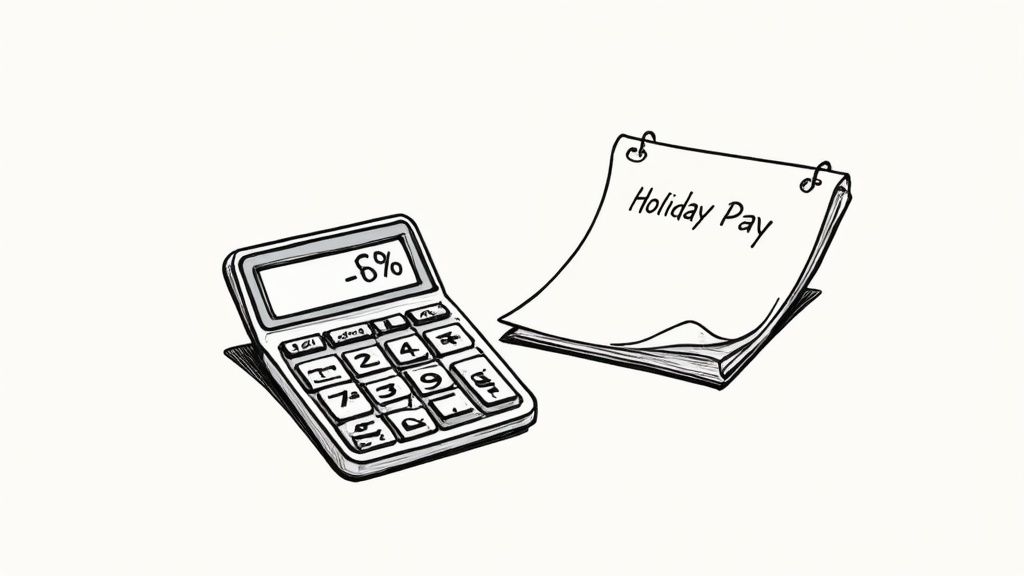
A Clear Guide to GOV.UK Holiday Entitlement
Posted by Robin on 06 Oct, 2025 in
Every single full-time employee in the UK is entitled to 5.6 weeks of paid holiday each year. This isn't just a company perk; it's a legal right.
For someone working a typical five-day week, this works out to 28 days of paid time off—crucial for resting, recharging, and avoiding burnout. This is the absolute legal minimum. Your company can always offer more, but they can never offer less.
Decoding UK Statutory Holiday Entitlement

Getting your head around holiday rights is the first step to making sure you're being treated fairly. The government sets a legal baseline to protect employee wellbeing, but figuring out how that baseline applies to your specific situation can feel like a bit of a minefield.
Let's break it down.
Think of the 5.6 weeks as the magic number, the universal starting point for almost everyone. It's a guarantee that covers full-timers, part-timers, and even people on zero-hours contracts. The system is designed this way—using weeks instead of days—to be flexible enough for the modern workforce.
The Core Calculation
At its heart, the rule is pretty straightforward. If you work a standard 5-day week, the maths is simple: 5.6 weeks multiplied by 5 days equals 28 days of paid leave. Easy.
But the real genius of the legislation is that it ensures fairness for everyone, not just those on a traditional Monday-to-Friday schedule. That’s why the entitlement is always framed in weeks.
Here’s a quick overview of how the statutory minimum holiday entitlement works based on the days you work.
Statutory Minimum Holiday Entitlement At a Glance
| Days Worked Per Week | Minimum Holiday Entitlement (Days) |
|---|---|
| 5 | 28 |
| 4 | 22.4 |
| 3 | 16.8 |
| 2 | 11.2 |
| 1 | 5.6 |
This pro-rata system ensures that part-time staff receive an equivalent amount of leave relative to the hours they put in, which keeps everything fair and square across the board.
Who Is Entitled to This Leave?
The short answer? Pretty much all workers. This includes:
- Full-time employees working a set number of hours each week.
- Part-time employees, whose leave is simply calculated on a pro-rata basis.
- Workers on zero-hours contracts, who build up leave based on the hours they actually work.
- Agency workers, once they've been with the same hirer for 12 weeks.
For UK contractors, things can get a bit more complex. Understanding your holiday rights often depends on how umbrella companies legally employ contractors and handle their payroll, as this relationship defines how holiday pay is managed.
A key thing to remember is that statutory holiday entitlement is a right from day one. There’s no qualifying period before you start earning leave, although some companies might restrict when you can take it during a probationary period.
What Is Not Included?
It's also important to know the limits. The 28-day minimum is exactly that—a minimum. Your employment contract is the final word on what you actually get.
An employer can be more generous, offering extra days off or treating bank holidays as separate from your core 28-day allowance. What they can't do is go below the 5.6-week legal requirement. Understanding this difference between the legal floor and your contractual benefits is crucial for everyone.
Calculating Leave for Part-Time and Casual Workers
Not everyone works a standard nine-to-five, five-day week, which is where getting your head around gov.uk holiday entitlement becomes really important. When your team includes part-time staff or casual workers, the sums change, but the principle of fairness doesn't. Let's break it down.
For part-time employees who work the same days each week, the process is wonderfully straightforward. You can put the complex formulas away; all you need is a quick multiplication.
The core rule is that everyone gets 5.6 weeks of leave. To figure out what that means in days for a part-time worker, you just multiply 5.6 by the number of days they work each week.
The Part-Time Calculation Made Easy
Let’s run through a real-world example. Imagine you have a team member, Sarah, who works three days a week.
- Calculation: 5.6 weeks x 3 days per week = 16.8 days of paid holiday per year.
It’s that simple. If another colleague, David, works two days a week, his entitlement would be 5.6 multiplied by 2, which gives him 11.2 days of annual leave. This pro-rata system makes sure part-time staff receive the same proportion of leave as their full-time colleagues.
An important point to remember is that you can't round down holiday entitlement, but you can round it up. So, while Sarah is entitled to exactly 16.8 days, a company might choose to round this up to 17 days in its policy.
The process of tracking monthly accrual for a new employee is straightforward, as this infographic shows.

This visual shows how a new starter builds up their full entitlement over the year, reinforcing that holiday leave is earned consistently from day one.
Demystifying Leave for Casual and Zero-Hours Workers
Calculating leave for workers with irregular hours, like those on zero-hours contracts, needs a different approach. Because their working patterns are unpredictable, the government guidance points towards a method based on hours worked.
The standard calculation uses a specific percentage: holiday is accrued at 12.07% of the hours worked.
That number might seem a bit random at first, but it’s directly tied to the statutory 5.6 weeks of leave. Here's the maths: it’s calculated by dividing the 5.6 weeks of holiday by the remaining 46.4 working weeks in a year (52 total weeks - 5.6 holiday weeks). This gives us 0.1207, or 12.07%.
Let's see this in action:
- Scenario: A zero-hours worker clocks 40 hours of work in a month.
- Accrual Calculation: 40 hours x 12.07% = 4.828 hours of paid holiday earned.
This means for every hour they work, they earn just over seven minutes of paid leave. While this method provides a fair way to calculate entitlement for irregular hours, keeping track of it manually for multiple team members can quickly become a huge admin headache.
If you're looking for an easier way to handle these calculations without the manual effort, you might be interested in our guide to using an automated holiday calculator for UK leave.
Managing these varied working patterns is essential for staying on the right side of the law. Ensuring every team member, regardless of their contract, receives their correct holiday entitlement is a cornerstone of being a fair employer. Getting this right not only keeps you compliant with gov.uk holiday entitlement rules but also builds trust and morale within your team.
How Bank Holidays Impact Annual Leave

Here in the UK, one of the biggest points of confusion around annual leave is how bank holidays fit into the picture. Ask most employees, and they’ll probably tell you these are automatic, paid days off on top of their standard holiday allowance. The reality, however, is a bit different and hinges entirely on the wording of their employment contract.
It's a common myth that there's a legal right to paid time off for bank holidays. There isn't. UK employment law is clear: there’s no automatic statutory entitlement. While full-time employees must receive 28 days of leave, it’s up to the employer to decide whether bank holidays are counted within this total or given as extra days. You can explore detailed guidance on UK bank holidays to get deeper into this contractual distinction.
This flexibility means employers generally take one of two routes when setting up their policies.
Two Common Contractual Approaches
How you handle bank holidays must be spelled out in the employment contract. This document is the single source of truth, preventing any confusion down the line for both the employee and the business.
You’ll almost always encounter one of these two scenarios:
- Inclusive Approach: The contract states that the employee gets 28 days (or 5.6 weeks) of annual leave, inclusive of bank holidays. This means the standard bank holidays are simply treated as part of the total 28-day statutory minimum.
- Exclusive Approach: The contract specifies the employee is entitled to 20 days (or 4 weeks) of annual leave plus bank holidays. This is the more generous option, giving a full-time employee 28 paid days off, with the eight or so bank holiday dates effectively pre-booked.
Neither approach is right or wrong, but clarity is everything. If a contract is vague or silent on the matter, it can lead to messy disputes. Precise wording from day one is non-negotiable.
An employer can legally require an employee to work on a bank holiday. This is pretty standard in sectors like retail, hospitality, and healthcare. If that's the case, the contract must be clear about compensation, which is usually a day off in lieu.
Ensuring Fairness for Part-Time Workers
Things get particularly tricky when managing part-time staff. A rigid, one-size-fits-all policy can easily lead to unfairness. The classic problem arises when a bank holiday falls on a day a part-time employee doesn't normally work.
Think about it: most bank holidays land on a Monday. If you have someone who works Tuesday to Thursday, they’ll miss out on all those paid days off. Meanwhile, their colleague working Monday to Wednesday gets them all. That’s discriminatory.
To handle this correctly, employers need to give part-time workers a pro-rata entitlement to bank holidays, no matter which days they work.
Let’s walk through a quick example:
- Full-time baseline: A full-time employee gets 8 bank holidays per year.
- Part-time calculation: A colleague works 3 days a week (that’s a 0.6 full-time equivalent).
- Pro-rata entitlement: They are entitled to 0.6 x 8 = 4.8 days of paid bank holiday leave for the year.
If a bank holiday falls on one of their normal working days, it simply gets deducted from this 4.8-day allowance. If it falls on a non-working day, they can use that accrued time off at another point. This simple calculation ensures they receive the exact same proportional benefit as their full-time peers and is key to complying with gov.uk holiday entitlement regulations.
Managing Leave for Sickness, Carry-Over and Leavers
Life happens. People get sick, sometimes for long stretches, and eventually, they move on to new opportunities. When these things occur, figuring out holiday entitlement can feel a bit tricky. Getting it right isn't just about ticking a legal box; it's about being a fair and decent employer.
Let's walk through how to handle these common but crucial situations. We'll look at the rules for carrying over unused leave when someone's been off sick, and then break down exactly how to calculate final holiday pay when an employee leaves.
Holiday Accrual and Carry-Over During Sickness
A question that pops up all the time is what happens to someone's holiday allowance when they're on sick leave. The answer is straightforward: it keeps building up as normal. An employee's right to paid holiday is protected by law, even if they're off work for a long time.
This means that if a team member is on long-term sick leave, their statutory holiday pot is still growing in the background. Unsurprisingly, this can lead to them having a lot of unused leave by the time the holiday year ends.
Normally, the first four weeks of statutory leave operate on a "use it or lose it" basis. Sickness, however, is one of the key exceptions to that rule.
If an employee can't take their holiday because they are on sick leave, they have the right to carry over up to four weeks (20 days for a full-time worker) of unused statutory leave. They must then use this carried-over leave within 18 months of the end of the leave year it was accrued in.
This rule is in place for a simple, humane reason: no one should miss out on the rest and recovery that paid holiday provides just because they were unwell.
Calculating Final Holiday Pay for Leavers
When an employee hands in their notice, one of the final admin tasks is to calculate their final holiday pay. This involves working out how much holiday they've earned up to their leaving date and squaring that against how much they've actually taken.
The goal here is to make sure they're paid for any holiday they've earned but not used. On the flip side, it also allows you to reclaim pay if they’ve taken more holiday than they were entitled to.
Let's break the calculation down into a few simple steps.
Step-by-Step Calculation Process
- Figure out the proportion of the year they worked: Divide the number of days they were employed in the current leave year by 365.
- Calculate their accrued holiday: Multiply that fraction by their full annual entitlement. So, for a full-time employee with 28 days' leave, this tells you precisely how many days they've earned.
- Compare what's accrued vs. what's taken: Simply subtract the number of holiday days they've already used from their accrued total.
Here’s a quick example to make it real:
- Scenario: An employee on a 5-day week with a 28-day entitlement leaves exactly halfway through the holiday year (on day 182.5).
- Accrual: They've earned exactly half of their annual leave, which is 14 days.
- Final Pay: If they've only taken 10 days of leave, you owe them pay for 4 days. But if they've taken 16 days, you can deduct the pay for the 2 extra days from their final salary (as long as your employment contract allows for this).
The government's own website provides clear guidance on these calculations and employee rights.
This screenshot from GOV.UK shows how fundamental these rules are. Understanding pay for leavers is a core part of the gov.uk holiday entitlement framework that every employer needs to know.
For a deeper dive with more examples, have a look at our complete guide on holiday entitlement when leaving a job. Getting these final numbers right ensures a smooth, professional offboarding process for everyone involved.
Best Practices for Holiday Policy and Compliance

Knowing the gov.uk holiday entitlement rules is the first step, but putting them into practice is where things get interesting. The bedrock of good leave management is a crystal-clear, comprehensive, and legally sound annual leave policy. Get this right, and you’ll prevent a world of confusion, ensure fairness, and protect your business from potential disputes down the line.
Your policy needs to be the single source of truth for both managers and employees, leaving no room for guesswork. Think of it as the ultimate guide to requesting, approving, and tracking time off. This isn't just about ticking compliance boxes; it's about building a transparent and trusting workplace.
Crafting a Watertight Annual Leave Policy
A strong holiday policy should be written in plain English, free from confusing jargon. It needs to be dead easy for everyone to find, whether that’s in an employee handbook or pinned to the company intranet.
Essentially, it's the user manual for taking a break. Here are the must-haves for any solid policy:
- The Leave Year: State clearly when your company's holiday year starts and finishes (e.g., 1st January to 31st December).
- Total Entitlement: Specify the exact number of days or hours of leave an employee gets, and be explicit about whether this figure includes bank holidays.
- Booking Process: Map out the exact steps for requesting time off. Who do they ask? How much notice do they need? Who gives the final nod?
- Restrictions: Be upfront about any blackout periods when leave might be restricted, like during your busiest season. Also, explain any rules around taking long stretches of leave at once.
- Carry-Over Rules: Outline your policy on carrying over unused leave into the next year. Don't forget to mention any legal minimums, especially for carry-over related to sickness.
Having a clear policy is half the battle. To make it even easier, check out our guide on creating a template annual leave policy.
Encouraging a Culture of Rest and Recovery
A generous leave policy is pretty pointless if your team feels too guilty or anxious to actually use it. A culture where people are hesitant to take time off is a fast track to burnout, plummeting productivity, and a revolving door of staff.
Sadly, a lot of UK workers don't take their full entitlement. Research from 2024 shows that while the average allowance is around 22 to 23 days (plus bank holidays), employees leave an average of five days unused each year. This trend has a real impact on businesses.
Actively encouraging staff to take their holidays is one of the best investments a manager can make. Well-rested employees are more creative, engaged, and productive. It’s not a luxury; it’s essential for a healthy and high-performing team.
To really foster a better work-life balance, managers need to lead by example and take their own holidays. It also makes a huge difference to regularly check in on leave balances and gently nudge team members with a lot of days left to book a break. This is where a system like Leavetrack comes in handy, giving you instant visibility into who needs to switch off, making proactive management simple and effective.
Common Questions About UK Holiday Entitlement
Getting your head around the rules for gov.uk holiday entitlement can throw up a lot of specific, real-world questions. The basic principles might seem straightforward, but things can get complicated when you apply them to everyday situations. This section cuts through the noise and gives you direct answers to the questions we hear most often, saving you from trawling through dense legal text.
We'll cover everything from how much notice you need to give for a holiday to how your pay is calculated when you're off. Let's dive into the common scenarios that managers and employees face every day.
How Much Notice Do I Need to Give to Book a Holiday?
This is easily one of the most common points of confusion. Unless your employment contract says something different, the simple rule of thumb is that you need to give notice that is twice as long as the holiday you plan to take.
- For a one-week holiday (five working days): You'll need to give your boss at least two weeks' notice (ten working days).
- For a single day off: You should give at least two days' notice.
Just remember, this is the bare minimum required by law. Most companies will have their own procedures laid out in an annual leave policy or employee handbook, so that should always be your first port of call.
Can My Employer Refuse a Holiday Request?
In short, yes. An employer can turn down a holiday request, but they can't do it on a whim – they need a solid business reason. Common justifications include hitting a really busy period, facing staff shortages, or dealing with too many team members asking for the same time off.
An employer also has to give you enough notice if they're going to refuse a request. The notice they give you must be at least as long as the holiday you asked for.
For example, if you've booked a two-week holiday, your employer has to tell you that you can't take it at least two weeks before it’s scheduled to start. If they don't give you the proper notice, they may not be able to cancel it.
What Happens If I Don't Use All My Holiday?
This really depends on your company's policy and the type of leave we're talking about. The first four weeks of your statutory holiday are generally "use it or lose it" – you can't be paid for them instead, unless you're leaving your job.
That said, many employers will let you carry over a certain number of days into the next leave year. Your contract should spell out if this is an option and, if so, how many days you can move across. Keep in mind that leave carried over because of long-term sickness is a different kettle of fish and has its own specific rules.
How Is My Holiday Pay Calculated?
For anyone with fixed hours and a regular salary, holiday pay is simple: you get paid what you normally would. If you work a five-day week and take a week off, your payslip should look the same as any other week.
It gets a bit trickier for people with irregular hours or whose pay changes week to week, perhaps due to commission or overtime. For them, holiday pay must be calculated based on their average pay over the previous 52 paid weeks. Any weeks where you earned nothing are skipped, and they just go back further until they have 52 weeks of pay data. This system is designed to make sure your holiday pay is a fair reflection of what you actually earn.
Can My Employer Force Me to Take Holiday?
Yes, they can. An employer has the right to tell you to take your statutory holiday on certain dates. The most common example of this is a mandatory company shutdown over the Christmas break.
Just as with refusing leave, they have to play by the rules and give you the right amount of notice. The notice period must be at least twice as long as the holiday they're making you take. So, if they want to enforce a two-week shutdown, they need to let everyone know at least four weeks beforehand.
What if I Get Sick While on Holiday?
If you fall ill just before you're due to go away or during your annual leave, you have the right to count that time as sick leave instead. You just need to follow your company's standard sickness reporting process, like calling your manager and getting a doctor's note if that's part of the policy.
The days you were sick can then be added back to your annual leave balance to be taken at a later date. It’s a protection that ensures you don't lose your well-earned time off just because you were unlucky enough to get sick.
Government bodies often need to gauge public understanding on official guidance, like UK holiday entitlement. To do this, they might use specialised government survey tools designed to collect this kind of feedback effectively.
Getting a handle on these common situations helps clear up the rules and gives both employers and employees the confidence to manage leave fairly.
Managing annual leave doesn't have to be a constant headache of spreadsheets and back-and-forth emails. Leavetrack provides a simple, clear system to handle requests, approvals, and tracking, ensuring you're always compliant and your team knows exactly where they stand. Discover a better way to manage time off at https://leavetrackapp.com.
